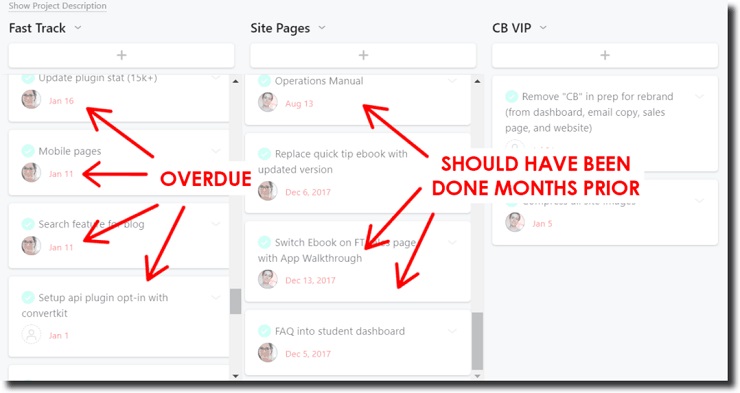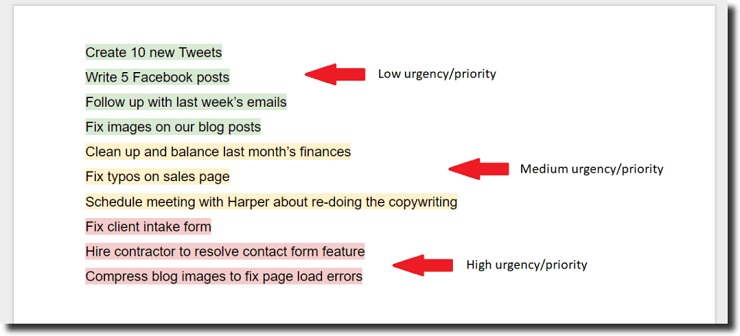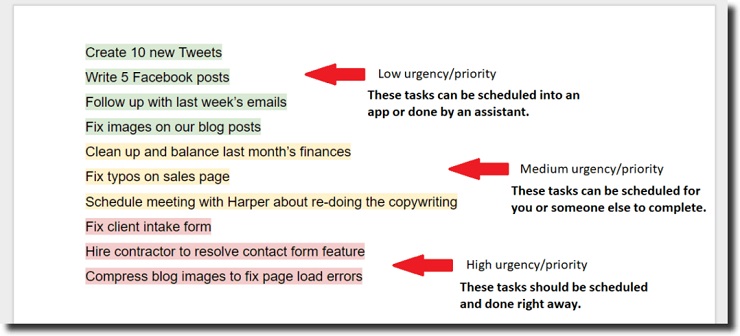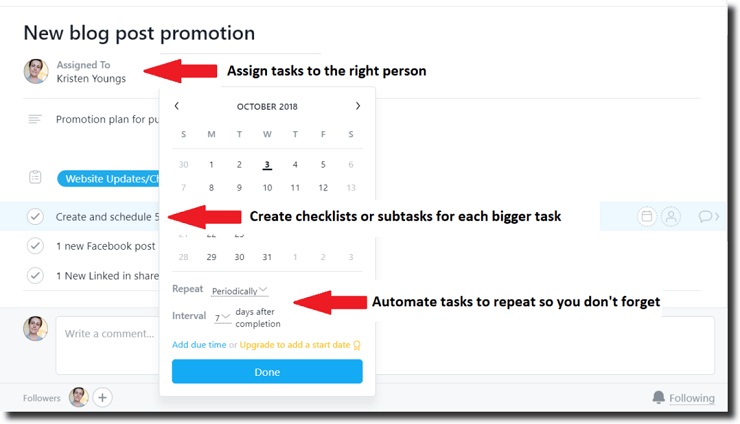This may sound like a sleazy, too-good-to-be-true marketing pitch, but you could be doubling or even tripling your business growth, without any kind of dramatic pivot, new business plan, or aggressive new program. In fact, there’s a good chance you need to be doing much less.
See, most startups and founders get so lost in the hustle of finding success, they end up taking on way too many projects. And the results are lousy, because you and I both know, as hard as we might try to change the fact, there are only so many hours in a day.
Taking on more projects doesn’t always translate to growth. In fact, it can easily lead to things like rescheduled meetings, putting projects on the backburner, and leaving your ideas sitting and waiting until you can find time to get around to them…someday.
If you’ve found yourself in this situation—where you’ve spread yourself so thin, you feel like you’re constantly taking two steps back in order to take half a step forward—you gotta find your way out.
Fortunately, all it takes is a little house cleaning. Clear away all the clutter you’ve surrounded yourself with, and watch your growth trajectory surge.
Keep reading to learn how to stop feeling like all of your days are spent catching up or putting out fires, and instead, get back on the path toward increased productivity and business growth.
Are You Managing Business Growth? Or Are You in Reactive Mode?
Reactive mode is a term I use to describe far too many entrepreneurs and founders (at one point, I used it to describe myself). It’s often the result of starting up quickly out of pure necessity, and growing alongside customer demands until they swamp you.
Now, don’t get me wrong—reactive mode is typically the result of success. What’s wrong with growth and customers needing your help, right? The “problem” is when you’re not sufficiently prepared for that success and don’t have a proper plan for managing growth.
Let’s say you come up with a business, product, or service to solve an immediate solution in your market. Maybe you start small with a minimum viable product or prototype. You might even get funding to move forward and launch to an even larger audience.
As a new founder or entrepreneur, though, you might not be set up for a larger audience yet. And when customers come knocking at your door, it can be nearly impossible not to “react” and simply give them what they need before stopping to analyze how you should best provide those needs.
In reactive mode, you might find yourself:
- Hiring employees or assistants out of desperation and overwhelm
- Feeling too disorganized to visualize continued business growth because you’re focused on playing catch up
- Working, working, and working, but never feeling caught up
The problem with those scenarios is, quite simply, the lack of a solid plan.
Do you have an onboarding process set up for bringing on new employees or assistants? Have you put actionable steps in place to help clear out your long list of “to-dos?” Is all the work you’re doing actually moving you forward, or is it completely burying you, with more and more projects piling up?
Reactive mode often eats up and spits out new entrepreneurs. They get a taste of upfront success, but once they’ve reached their limits, find themselves in a plateau because, to put it simply, they’re swamped.
Technically, it looks something like this:
Realistically, it looks a little more like this:
Reactive mode can leave you overwhelmed and exhausted, like you’re running on a treadmill and constantly increasing the speed, but never actually getting anywhere.
It doesn’t have to be your new norm, though. You can break free of the “hustle plateau” and finally manage business growth.
Pinpoint Priorities and Cut the Fat
To get yourself and your business out of reactive mode, you need to start with the absolute basics.
Find Out Where Your Time is Going
Pull up your last month’s schedule. If you don’t have one, write out a list of all the tasks you completed. It could be things like “fixed the email marketing campaign,” “reached back out to Jane about partnership,” or “fixed responsiveness on our home page.” No matter how big or small, write down everything you did last month.
Here’s what a month of reactive mode for me looked like:
There’s something every “reactive mode” task has in common.
They’re all about fixing things or catching up.
Fixing broken email sequences. Fixing forgotten business relationships. Fixing bugs and errors.
It goes on and on.
What you don’t see in reactive mode are things like “launched a new sales campaign,” “published three new press releases,” or “used data from our survey to implement X change.”
The problem is, while “fixes” involve a lot of work, they don’t produce results. It’s the results that are missing. But it’s the results that matter.
Now take a look at what a results-driven month looks like for me:
Compared to reactive mode, the tasks are no longer about fixing what’s broken or catching up with late tasks. Instead, projects are results-driven—they’re all focused on producing positive outcomes.
So, how do you get there? How do you go from a constant state of “fixing,” to a task list that actually produces results?
Categorize Your Tasks
You have a list of all the tasks you completed last month. Now, it’s time to categorize those tasks using three different labels:
- Low priority and low urgency
- Medium priority and medium urgency
- High priority and high urgency
If you’re more of a visual person like me, you could use post-it notes with different colors and write each task on individual post-its based on a color category. (Green, yellow, and red are good choices.) You could even list out your tasks on a Google Doc and highlight them with category colors.
Here’s an example of what that might look like:
Once you have all your tasks categorized, not only can you see where all your time is going (and how important those tasks really are), but also how you can strategically change the way those tasks can be handled in the future.
Any low priority, low urgency task (or green task), for example, can be handed off to an assistant, employee, or app in the future. Examples of such tasks might be things like social media management, sending follow up emails, or backing up project files. They’re tasks that need to be done, but could easily be done by someone other than you.
Mid-level tasks (the yellow ones) might need to be completed by you or a partner, but don’t necessarily need to be taken care of right away. They’re important, but not highly urgent. These tasks should be scheduled into your calendar to be completed one at a time—pace yourself so you don’t feel overwhelmed or burnt out.
The high priority and high urgency tasks (the red ones) need to be handled by you, right away. Those are the tasks you should be tackling at the very start of each day.
Start Trimming
As an entrepreneur, cutting the fat when it comes to your long list of to-dos can feel like the ultimate makeover. As someone who’s motivated and driven to build a successful business, though, it’s easy to fall into the trap of feeling like you have to do everything all at once.
You see other businesses running Facebook ads, so you decide to do the same. You read how every blog needs at least 2 new posts per week, so 2 new posts per week is what you write. You heard Instagram is the new Snapchat, so you quickly immerse yourself in the world of hashtags.
Not every endeavor produces results, though, and if you fail to step back and analyze where your time is going, and whether or not it’s giving you any return, you’ll spread yourself far too thin to ever see real progress.
My own perfect example of this was a foray into the world of Reddit. Despite the fact that I had a new product launch in the works, a series of broken email marketing campaigns, and a website that desperately needed its responsiveness fixed, I’d read how advantageous Reddit can be for business.
As I dove into Reddit, though, I saw absolutely no results. The reason? I didn’t have the bandwidth to learn how to properly use it. Therefore, not only was my focus being taken away from other, far more important and immediate projects, but my efforts on Reddit were futile because I simply didn’t have the time to learn how to use the platform for business.
With that in mind, let’s look back to your list of tasks from last month. For each one, ask and answer the following questions:
- Did this task produce a specific result—one I can measure in numbers? (Alternatively, will this task produce a specific result?)
- Is there a specific next step to take with this task?
- Was the result of this task worth the amount of time it took? (This one, of course, is a bit subjective.)
Go through every single one of your tasks and ask each of those questions. If any task gets a “no” for all three, it’s time to cut the fat and get rid of it.
Now, I do want to point out that so far, you’ve evaluated a month of tasks that have already happened. In the future, however, you should be doing this for upcoming months. Write down all the tasks and projects needing to be done, categorize them, and then assign or schedule each one accordingly.
Turn Success into a Cycle
Now that you know where your time is going, where it should be going, and how to plan correctly for the future, you need to turn the process into a cycle. Otherwise, all the steps above will just become another project added to the list, rather than a way of organizing and trimming that list.
Let’s recap before moving forward. Up to this point, you know:
- Which tasks you can completely eliminate from your business
- Which ones can be handed off to another person or automated with the use of an app or software (like your social media efforts)
- Which tasks bring real results and need to be scheduled and completed by you or a partner
By going through the process of categorizing, eliminating, and delegating, you should already be seeing a significant reduction in your workload, which means you can finally start looking forward again.
Keep It Organized
Before you do anything else, find a good project management app. My favorite is Asana, because it lets me create multiple projects with tasks, due dates, and assignees for each.
Whichever you choose (here’s a great roundup of options), consider it the new framework for your business. Use the app to schedule your following month’s tasks, set repeating dates where necessary, and delegate those tasks.
From here on out, every project should be added to your app and tracked until it’s completed (“completed” is the keyword here because remember, if you’re just “working” without producing any results, you’ll find yourself stuck on the hustle plateau).
With a consistent schedule where projects are seen through to completion, you’ll find yourself making progress without any drastic changes. You don’t need to launch a new project to put yourself back on the track toward managing business growth, for example. Simply finishing your existing tasks will do the same.
Plus, with unnecessary tasks no longer taking up your time, and low-priority projects being handled by an assistant or app, you will have time to start envisioning the future and looking forward again, which is exactly why this next step is so important.
Schedule Quarterly Maintenance to Manage Growth
Going through the process of “cleaning house” with your business is great, but if you only do it once, those same tasks and unfinished projects will start piling up again.
To make sure you continue managing growth and don’t accidentally slip back into old habits, schedule two or three days of business maintenance per quarter.
During that time, go through the exercises above where you looked back at all your tasks, decided which ones to eliminate, and categorized/delegated the rest. Instead of doing it for a single month, though, do it for the entire quarter.
By going through this process on a regular basis, not only will you be able to continually produce solid results in your business, you’ll also keep it agile, which means you can adapt, change, or pivot if needed.
With that flexibility, you can do things like hire a new employee with a specific job scope (versus hiring someone out of desperation and spending more time explaining the back end of your business to them than the amount of time they’re saving you). It could also mean seeking and gaining funding because you’re actually focused on numbers-driven results instead of tedious “work.”
To put it simply, keeping your business maintained and running like a well-oiled machine won’t just lift a huge weight off your shoulders, it’ll also open up new opportunities for your brand to expand, without you having to feel overwhelmed or overworked in the process.
Get Back on Track, Manage Business Growth
As the CEO or founder of a business, it’s nearly impossible not to feel stressed at times. If you’re like most entrepreneurs, you probably have an “I can do it all” mentality. Unfortunately, loading yourself up can quickly (and all too easily) lead you down a path toward burnout, and potentially failure.
That’s why giving your business a full evaluation and cleaning up your practices is so vital. It allows you to break free of the mindset that it’s all on you, and make room for positive growth.
But, how do you prepare? How do you find the time to sit down and go through each of these processes?
Alright, it’s time for a little tough love.
To be blunt, you will never have time. Never. You have to make it.
As a business owner myself, I know if I don’t set my schedule in stone, things won’t get done, because there’s always something else needing attention and somewhere else my time should go. You simply have to make the time to sit down and evaluate.
Think of it like a financial investment into a retirement account. Does it feel good to see a chunk of your paycheck being pulled out each month? I mean, you’re confident it’s going toward something that’s slowly growing and creating security, but it’d be nice to have that money go toward other bills and payments happening today, right?
There are a million ways you can invest time in your business. You can either focus on the “now” and handle all the little tasks as they come, or you can invest time for future success, even though you could definitely use that time now.
My money’s on the latter.
So go ahead and take a step back from your business. Give it a hard assessment, and see where you can clean it up. Doing so is the only sureproof way to stop yourself from constantly backtracking or sidestepping, and finally get back on the path toward managing business growth.
Are you in desperate need of a business clean up? Unsure about which tasks you should be letting go? Let me know in the comments below and I’ll help where I can!
























